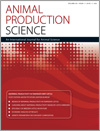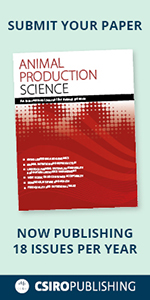
Animal Production Science
Volume 58 Number 1 2018
Maternal Productivity in Temperate Beef Cattle
ANv58n1_FOForeword to ‘Maternal Productivity in Temperate Beef Cattle’
AN12428A review of factors influencing key biological components of maternal productivity in temperate beef cattle
Cow–calf efficiency or maternal productivity is highly correlated with total system efficiency of beef production and needs to be balanced with modern consumer requirements. This review examined the key biological components of maternal productivity that were used as a guide for determining the appropriateness of different maternal productivity definitions. The recommended definition focuses on the cow–calf unit and possesses the capacity to facilitate improvements in beef-production efficiency.
AN13054Genesis, design and methods of the Beef CRC Maternal Productivity Project
Australian seedstock cattle breeders have expressed concerns that while there has been genetic improvement in feedlot and abattoir performance of cows, it could have led to a decline in maternal productivity, especially under variable nutritional conditions. This paper describes a substantial project with two components designed to address these issues.
AN14583Divergent breeding values for fatness or residual feed intake in Angus cattle. 1. Pregnancy rates of heifers differed between fat lines and were affected by weight and fat
Angus heifers with extreme estimated breeding values (EBVs) in rib fat depth (Fat) or post-weaning residual feed intake (RFI) were evaluated for their pregnancy rates. High-fat heifers had a greater pregnancy rate than Low-fat heifers. Pre-joining weight was the strongest determinant of likelihood of conception and pre-joining fat depth was also important. As expected, the days to calving EBV was the best EBV predictor of pregnancy success.
AN13218Divergent genotypes for fatness or residual feed intake in Angus cattle. 2. Body composition but not reproduction was affected in first-parity cows on both low and high levels of nutrition
This paper documents the impact of selection for reduced fatness and increased feed efficiency on nutritionally restricted, first-parity cows. The aim was to determine whether maternal productivity was compromised in these genotypes when energy input was restricted, with the result being that although body composition changed, there was no impact on reproductive traits. Producers can continue to select for reduced fatness and increased feed efficiency without compromising productivity of the female herd.
AN13295Divergent genotypes for fatness or residual feed intake in Angus cattle. 3. Performance of mature cows
The impact of selecting for traits such as increased carcass yield and improved feed efficiency in beef cattle on the productivity of the breeding herd is not well understood. This study evaluated the productivity of Angus cows that differed in genetic merit for either subcutaneous Fat or RFI. Clear associations existed between EBVs and cow body composition without significant effects on fertility in mature cows. There is opportunity to exploit genetic variance in traits such as fatness to best suit cow herd management and the target market.
AN14797Divergent breeding values for fatness or residual feed intake in Angus cattle. 4. Fat EBVs’ influence on fatness fluctuation and supplementary feeding requirements
Beef production systems’ costs are greatly affected by supplementary feed requirements. The inherited ability of cows to gain body condition while pasture is abundant, delaying supplementation onset during pasture shortage was examined. Cows with higher breeding values for fat take longer to require supplementation than cows with lower fat breeding values. Producers can utilise fat breeding values to better match cow genotypes to their production system.
AN14034Divergent breeding values for fatness or residual feed intake in Angus cattle. 5. Cow genotype affects feed efficiency and maternal productivity
A current concern of Australian commercial cattle producers is that selection for increased feedlot performance is leading to reduced productivity in the cow herd. Under low nutrition cows with high genetic rib fat had higher maternal productivity than those with low rib fat due to increased weaning rates. Cows selected for low residual feed intake had higher maternal productivity than high residual feed intake cows due to lower feed intake. In this context, including low residual feed intake and increased reproduction should be considered in a balanced beef breeding program.
AN14594Divergent breeding values for fatness or residual feed intake in Angus cattle. 6. Dam-line impacts on steer carcass compliance
This paper is on the progeny of cows in the Maternal Productivity trial. It has been clearly demonstrated that for grass finished carcasses, progeny of Low-Fat cows failed to reach market specifications. The implications of this are discussed.
AN15636Divergent genotypes for fatness or residual feed intake in Angus cattle. 7. Low-fat and low-RFI cows produce more liveweight and better gross margins than do high-fat and high-RFI cows when managed under the same conditions
Economic evaluation of experiments conducted on 500 Angus cows to measure maternal productivity performance provides direction to the national industry. Cows with low fat or low RFI generated more income by selling more liveweight due to heavier weights and higher stocking rates and therefore were more profitable, even when accounting for differences in reproductive performance. This finding has potential to influence breeding objectives.
AN13060Maternal body composition in seedstock herds. 1. Grazing management strategy influences perspectives on optimal balance of production traits and maternal productivity
Seedstock breeders’ perspectives on maternal productivity in beef cattle were investigated through the use of qualitative in-depth semi-structured interviews. Divergence in breeders’ attitudes to cow management and body condition fluctuation were evident and this was associated with differing selection emphasis for production traits compared with perceived resilience traits. The results demonstrated that among seedstock breeders targeting similar end markets, substantial variation in animal selection and management exists that requires further characterisation to ensure breeding programs and animal management are optimal.
AN13533Maternal body composition in seedstock herds. 2. Relationships between cow body composition and BREEDPLAN EBVs for Angus and Hereford cows
Relationships between BREEDPLAN estimated breeding values (EBVs) for 600-day weight, fat depth at P8 site (Rump), 12/13th rib fat depth (Rib), eye muscle area (EMA), and intramuscular fat (IMF) with body composition measures in first- and second-parity Angus and Hereford cows were investigated. BREEDPLAN EBVs for Rump, Rib, EMA and IMF were closely related to the equivalent ultrasound measure in Angus and Hereford cows at pre-calving and weaning. These results indicate that current BREEDPLAN carcass EBVs are associated with cow body composition, so if producers want to change the body composition of their cows, they can do so using existing BREEDPLAN carcass EBVs, and there appears no requirement for additional EBVs to describe cow body-composition traits for subcutaneous fat, EMA and IMF
AN15465Maternal body composition in seedstock herds. 3. Multivariate analysis using factor analytic models and cluster analysis
Understanding relationships between various characteristics in the development of cows at various stages of calving is of interest to the beef industry. A statistical approach was developed to determine the relationships using all the data simultaneously rather than in a piecemeal fashion. The results confirm the approach can be used to better inform the beef industry of relationships of interest.
AN13258Maternal body composition in seedstock herds. 4. Genetic parameters for body composition of Angus and Hereford cows
Australian beef producers have been successful in achieving significant genetic gains in body composition traits. This study examined the genetics of body composition traits of cows at pre-calving and weaning in their first and second parities. The results of this study indicate that genetic improvement in body composition traits in cows is possible, and that body composition information recorded at yearling age is a reasonably good predictor of later in life performance for these traits.
AN14577Maternal body composition in seedstock herds. 5. Individual-trait selection direction aligns with breeder perspectives on maternal productivity
Variation in selection direction and genetic merit for Angus seedstock herds that contributed the majority of the data to the industry herd component of the Beef CRC Maternal Productivity Project was in investigated. The main differences in genetic merit among herds were associated with rib fat and rump fat EBVs, but there were also differences in for weight traits. This outcome was consistent with prior qualitative research. Despite differences in genetic merit among herds being generally small, they will manifest themselves in different productivity outcomes depending on the management system.
AN13065Genetic divergence in residual feed intake affects growth, feed efficiency, carcass and meat quality characteristics of Angus steers in a large commercial feedlot
The cost of feed is the largest recurring cost of producing beef. Inherited variation in feed efficiency is known and this experiment was to demonstrate the benefit in a large commercial feedlot of breeding cattle for improved feed efficiency. The results obtained confirm the feed saving advantages of inherited superior feed efficiency and that previously reported trade-offs in carcass traits, while confirmed, were minor.
AN13321Selection for residual feed intake affects appetite and body composition rather than energetic efficiency
Feed costs are the largest single cost in any animal production enterprise with improvements in feed efficiency able to reduce feed costs. This study aimed to understand the basis for feed efficiency measured by residual feed intake and variation in maintenance requirements. The results obtained suggest that body composition, specifically fat deposition, is affected through inherent differences in feed intake or appetite rather than maintenance requirements.
AN13023Selection for increased muscling is not detrimental to maternal productivity traits in Angus cows
Sale value of cattle may improve with greater muscling, but it is important to establish whether maternal productivity is maintained. This research showed that selection for increased muscling in Angus cows was not detrimental to maternal productivity under average to good nutritional conditions. Beef producers can confidently increase muscling in British type cows to benefit from price premiums without reducing their maternal ability.
AN14874Modelling systems to describe maternal productivity, with the aim of improving beef production efficiency by eliciting practice change
Productivity of the cow has the largest effect on productivity of the beef industry particularly given the high cost of feeding cows. Recent research has demonstrated that cow productivity is impacted by (1) heifer development before puberty, (2) the effects the relationship between cow feed requirements and nutrient availability have on reproductive success, and (3) the changes in the cow herd that are a result of breeding decisions. Decision support systems based on computer simulation models can be developed to address these issues by providing outputs that help producers during their on-farm decision-making.



